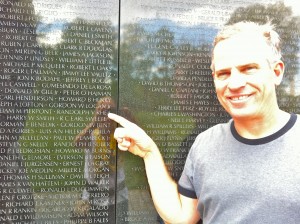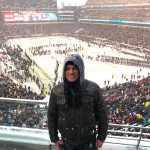 I graduated in the top 70% of my high school’s graduating class, so you have to imagine my surprise when they told me that I was receiving a college scholarship. It was called the “Randy Rhea Memorial Scholarship,” and it was designated for a Key Club member who was going to attend Fullerton College. I was the only Key Club member who fit the criteria, but who cares? I won $50! Woo Hoo! At the time, I was earning $4 an hour bussing tables at Disneyland, so I saw fifty dollars as a shift-and-a-half that I didn’t have to work.
I graduated in the top 70% of my high school’s graduating class, so you have to imagine my surprise when they told me that I was receiving a college scholarship. It was called the “Randy Rhea Memorial Scholarship,” and it was designated for a Key Club member who was going to attend Fullerton College. I was the only Key Club member who fit the criteria, but who cares? I won $50! Woo Hoo! At the time, I was earning $4 an hour bussing tables at Disneyland, so I saw fifty dollars as a shift-and-a-half that I didn’t have to work.
That Fall, I registered for classes at Fullerton College, and the $50 paid for my full semester’s tuition. I eventually graduated from Fullerton College with an Associate Arts degree in Real Estate, thanks at least in part to the Randy Rhea scholarship.
In 1988, I took a cross-country road trip which included a stop in Washington DC. I’d been there once before, but the Vietnam Memorial wall had been added since my last visit and it was my main point of interest. I wanted to see if I could find Randy Rhea’s name on the immense polished black granite walls of lost heroes. I found his name in the registry book with the identifying numbers Wall 16W, Line 66 amongst the other 58,256 names on the wall. I found the name I was looking for: Randolph V. Rhea, who I’d never met, but felt a connection to.
It’s an emotional experience when you stand in front of all those names. As a baseball fan, I knew that the seating capacity at Dodger Stadium is 56,000, so I imagined a packed house filled with fallen heroes who had paid the ultimate price.
Over the years, I was occasionally reminded of Randy Rhea. Usually during Veteran’s Day or at the Loma Vista Memorial Day service when Dave Dino sings, “My Buddy.” I had wondered about him over the years. What was he like? How did he die? Where was he buried? Eventually technology caught up to my curiosity and I decided to use the internet to find anybody who knew Randy. I started with a post on Facebook’s Fullerton Memories page. One day a couple of months ago, I posted a request for information about Randy. The response was immediate and overwhelming. Almost instantly I heard from Randy’s younger brother Darrel, and then other childhood and high school friends responded.
I spoke with Randy’s brother and his father Milt Rhea, both who now live in Washington. Milt is 89 years old, and a World War II veteran. He served as a landing craft driver in the South Pacific and shared his experiences in a book he authored called, “War is Hell.” He was a longtime, civic-minded resident of Fullerton who owned Kal Kustom Auto Interiors on Commonwealth across from the police station, and then Hillcrest Realty. He served in many community leadership including the NOC Red Cross and as President of Kiwanis club.
I told them about how I had always felt a connection to Randy. I drew inspiration from his sacrifice in my own life to enjoy the opportunity of living that he no longer had. I believe that you have an obligation to live the fullest life you can to honor those who gave their lives for your freedom. They gave their futures for you, so don’t waste the opportunity to live.
“I have two boys,“ I told Milt. “I can’t imagine the grief you and your wife experienced losing your oldest son at just twenty, but could you tell me about Randy?”
“A parent always thinks that their kid is the best,” Milt said matter of factly, “but he really was. He had a big heart and was fun to be around. He was just a sweetheart of a kid.”
Randy was born in Van Nuys, and moved with his family to Fullerton in the early 1950‘s. He attended Raymond Elementary, Wilshire Jr. High, and Fullerton High School, where he ran cross-country and graduated in 1967. He was in Boy Scout Troop 97 and enjoyed the outdoors. “He liked camping, and would try the most extreme things,” his brother Darrel said. “He was a gung-ho kind of guy.”
After one semester attending Fullerton Junior College, he enlisted in the army and excelled at basic training enough that he was chosen for a Special Forces unit. “Only one out of a thousand are chosen, “ Darrel proudly said of his big brother’s accomplishment.
“He went into the Green Beret training, which I didn’t really like, but he loved it. He thought it was the greatest thing in the world,” Milt remembered about his son. He said that Randy enjoyed the camaraderie with the other soldiers and his confidence in his own abilities grew. “I told him don’t be a hero, if you find yourself in trouble dig a hole,” was Milt’s advice to his son, “Sure enough, that’s the way he died.”
His team’s job was to follow the movements of the Viet Cong. It was rough duty and twice he was the only surviving member of his Green Beret team. I always thought of Randy as a survivor,“ Darrel said. “He was always going to be able to out-smart the circumstance.”
To finish out his tour of duty, he was stationed at a remote helicopter base. A helicopter was hit by mortar fire and crash-landed. Randy went out to save a friend from the wreckage, and on a return trip to the wreckage, he was hit by a bomb and killed.
“I know the story is true because after their tours two soldiers who were there when it happened came and told me the details of that day.” Milt said.
For his efforts, Randolph V. Rhea was posthumously awarded the Silver Star for bravery.
Randy’s full-military funeral with a 21-gun salute was held at Morningside Presbyterian Church. An over-flow crowd of hundreds filled the church and dozens more paid their respects from outside the church. He was interred at Loma Vista Memorial Park right in front of the mausoleum where the yearly Memorial Day ceremony takes place. The American flag that draped his coffin remains to this day in the possession of his father.
Several of Randy’s army buddies who returned from the war eventually named their own sons after Randy. His brother Darrel named his son after Randy too. “My son, Randolph Wallace Rhea, is working on a Ph.D. in “Peace and Conflict Transformation,” Darrel said of his brother‘s namesake.
“I think what I learned most from my brother’s death was how many people a single war casualty could impact. There were hundreds of people touched by his death, and many are still moved by the loss. Going to high school reunions was emotional for me, so many people would come up to me in tears to talk about how significant his death was to them. I found myself having to relive my grief over and over. Twenty years, thirty years, forty years later, people still hurt from it. I can see the multiplier of pain for the 50,000 men we lost in Vietnam, and shudder to think of the scope of pain for the millions killed in WWII. The impact of war is enormous, and a lesson civilization seems to have to relearn every generation.” said Darrel Rhea.
After speaking with Milt and Darrel Rhea, I went out to Loma Vista Memorial Park to visit Randy’s grave. I like to leave a coin on the headstone when I visit a grave, so I reached into my pocket for a penny, and it just so happened to be a 1969 penny – 45 years old, and the same year that Randy died – coincidence?
After thirty years of wondering, it was fulfilling to finally learn about Randy, and how he lived, served, and died. It was heartwarming to hear about all the lives he impacted in his too-short twenty years on Earth. Even after all these years, he is still loved and remembered fondly by those whose life he touched.
“When Randy died, people gave me money in lieu of flowers. Well, I didn’t want to keep it for myself, so through Kiwanis we set up a scholarship in Randy’s name.”
The first scholarship was given out in 1970, and has been awarded every year since. This year’s scholarship winner will be awarded $600.
For more information or to make a donation to the Vietnam Veterans Memorial Fund, visit their website at www.VVMF.org . You can donate directly to the Randy Rhea Memorial Scholarship through the Kiwanis Scholarship fund at Fullerton College Foundation, P.O. Box 431, Fullerton, CA 92836





